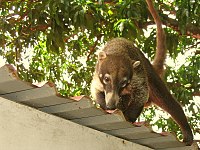
Photo from wikipedia
Carnivores are important elements of Neotropical biomes that are in need of conservation efforts. However, successful conservation methods rely on the identification of accurate evolutionary taxa. Unfortunately, in the case… Click to show full abstract
Carnivores are important elements of Neotropical biomes that are in need of conservation efforts. However, successful conservation methods rely on the identification of accurate evolutionary taxa. Unfortunately, in the case of Procyonidae systematics, there has been little knowledge in some genera. Two of these genera are Nasuella and Nasua, also known as the coatis. Herein, we analyzed a dataset obtained in South America and Central America, containing sequences of three mitochondrial genes (ND5, Cyt-b, and D-loop) collected from 42 mountain coati (Nasuella olivacea) specimens, plus 50 white-nosed coati (Nasua narica) and 51 ring-tailed coati (Nasua nasua) (total sample of 143). Our results support four main findings. (1) We detected four significantly different groups of N. olivacea. There were two small groups, one distributed in the Central Colombian Andean Cordillera and Western Ecuadorian Andean Cordillera, and another in the Western Colombian and Ecuadorian Andean Cordilleras. The specimens of these small groups were phenotypically un-differentiable from N. olivacea, but their mtDNA were more related to that of N. nasua than to the mtDNA of the other N. olivacea. The other two groups of N. olivacea contained the major part of the specimens analyzed. One is in the Eastern Colombian Andean Cordillera and is molecularly un-differentiable from the proposed “new” endemic Venezuelan species, Nasuella meridiensis. The ancestor of this group gave origin to another expanded group in the Western and Central Colombian and Ecuadorian Andean Cordilleras. (2) Different analyses (network, temporal splits, genetic diversity analyses) showed that the mitochondrial haplotypes of N. nasua were the first to appear (temporal diversification during the Late Miocene, and Pliocene), followed by the haplotypes of the current groups of Nasuella (temporal diversification during the Pliocene and beginning of the Pleistocene), and then the haplotypes that of the Central American N. narica (temporal diversification during the Pleistocene). Within N. nasua, we detected, at least, four highly differentiated groups that contain cryptic species or highly differentiated subspecies. (3) All of the taxa we analyzed showed high levels of mitochondrial genetic diversity, but N. nasua showed the highest levels, whereas N. narica showed the lowest levels. (4) Some groups of N. olivacea, and N. narica showed Pleistocene population expansions, but all the taxa showed a very strong signal of population declination in the last 20,000 years ago (YA), which could be correlated with the drastic climatic changes in that epoch.
Journal Title: Mammalian Biology
Year Published: 2020
Link to full text (if available)
Share on Social Media: Sign Up to like & get
recommendations!